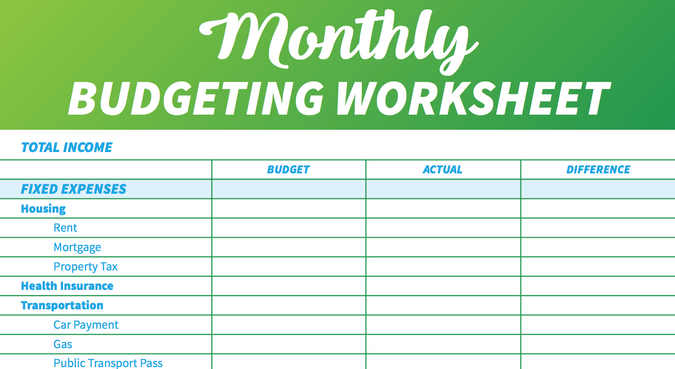How To Set a Realistic Budget You Can Live With

Day 2: GOBankingRates wants to help you Live Richer. Throughout the month of July, we’ll be sharing daily tips for how you can do just that, with advice on budgeting, saving, investing, making the most of your career and managing debt — plus money advice for every phase of your life. Check back each day during our 31 Days of Living Richer to learn everything you need to know to set yourself up for financial success and live the richest life possible.
If you struggle with managing money, you’re not alone. A GOBankingRates survey found that 40% of Americans have less than $300 in savings. That makes it hard to handle emergencies. Budgeting can help.
Day 1 of Living Richer: The Top 3 Budgeting Tips From Experts
Read: What It Means To Live a Truly Rich Life and How To Achieve It
There are many ways you can prepare a budget that suits your needs, particularly if it’s your first time. Take a look at this guide to help you get started.
What Are the Benefits of Budgeting?
Budgeting money doesn’t mean buckling down and never having a latte again. When it comes to how budgeting helps, it means:
You know how much money is coming in and how much is going out. Based on your priorities, you decide how much you want to spend on flexible expenses.
You have a road map to your short- and long-term financial goals. After budgeting living expenses, you find money for other goals, like saving and paying down debt.
You understand what your income and expenses are. You avoid getting to the end of a month and wondering what happened to your money.
Find Out: 17 Biggest Budgeting Mistakes You’re Making
Types of Budgeting Methods
When it comes to how to approach budgeting, there’s an option for everyone. Here are some popular methods:
50/30/20: Developed by Sen. Elizabeth Warren, this budgeting method allocates 50% of your income to your needs, 30% to wants and 20% to building up savings and paying down debt.
Zero-based budgeting: With zero-based budgeting, you allocate all of your income so that your income minus your expenses equals zero. Every dollar that comes in has a function.
Envelope method: Popularized by Dave Ramsey, this method uses cash in envelopes to control spending. Each spending category has an envelope, and once the money is gone, you stop spending.
Flexible budgeting: With a flexible budget, you reallocate your income and expenses as they change. This allows more flexibility, but it takes more time to manage.
Static budgeting: As the name indicates, a static budget stays the same even if your income increases.
80/20: You focus on setting aside 20% of your income for savings. Everything else comes from the remaining 80%.
How To Create a Budget

Budgeting and forecasting isn’t always easy, but knowing the way to start can help. These step-by-step instructions for how to create a budget will get you going:
Budgeting Tips for Beginners
The best budget is one you can stick to. Here are a few tips.
What’s a Good Budget for You?
You want a budget that’s realistic. You may want to start with a few broad spending categories and narrow them down as you learn your spending patterns.
An elaborate budget may not be realistic. It’s OK to start slowly and with small goals. Even adding a small amount to savings each week adds up over time.
Choosing a Budgeting Method
The 80/20 budget is a good starting point since its goal is to help you build up your savings. The 50/30/20 budget is another beginner-friendly option since it helps you focus on what’s important: covering essential expenses, saving and paying down debt.
Any budgeting method can work, but it might take some experimenting to find the right one for you.
Find Out: Why You Should Start Budgeting Now for 2022
Use Tools and Budgeting Apps
Many banks offer tools to automate recurring payments and analyze your spending. You can also look at the many budgeting apps out there. Check user reviews and forums to see what might work best and what’s reliable.
Avoid Fads
Financial gurus are constantly offering what seems like new and exciting budgeting advice. While it might be tempting to go with a new method, it’s best to stick with what works for you.
If you’re a longtime user of an app or method, you have an established history that you can use to inform your decisions. If you want to try a new app or method, consider what sets it apart from what you’re doing now. Is it really better? Is it user-friendly? If so, make the switch slowly.
What To Consider When Making a Budget
Income and expenses might vary month by month. Preparation is key to riding them out while sticking to your budget. Consider the following factors that could affect your budget.
Irregular Income
Budgeting can become an issue for self-employed and commission-based workers. It could also come into play with a side business. Once all monthly budget items are covered, this money can go to faster debt payoff, wants or savings.
Discover: What Counts as Taxable Income?
Irregular Expenses
These expenses are predictable but infrequent. Property taxes and periodic car maintenance are examples. You can budget the amount in a specific month. Or, if you have less flexibility, a monthly contribution toward that eventual expense might work better.
Emergencies
These are irregular expenses that you can’t predict, such as a hospital visit or storm damage to your home. Create an emergency fund for these items by setting aside a percentage of income or maintaining a fixed amount in your savings account.
How To Improve Your Budgeting Process
When it comes to how to budget and save money, you’ll find that it’s an ongoing process. The best approach is to work to improve your approach regularly. Here are a few ways to do it.
Weekly and Monthly Monitoring
Each week, touch base with other spenders in your household so you’re on the same page with your income and expenses for the week.
Budgeting and forecasting should take place monthly. Look at the previous month and evaluate your spending as compared to your budget. One way to do this is by:
Making a column for your spending budget
Making a column for your actual spending
Determining the percentage you spent in each category
Calculating the difference between your budget and your actual spending
Check Out: Are You Spending More Than the Average American on 25 Everyday Items?
Adjusting and Reevaluating
Use your monthly monitoring to decide your budget percentages for the next month. Look at categories where you overspent and allocate funds or cut spending in those categories.
Building a Habit
Consider whether the method or app you used for the last month worked for you. Check in with your budget on a regular schedule. Set alarms or calendar appointments to monitor your budget.
Reflect on budget mistakes, but don’t let them hold you back. Regroup and keep going so you can meet your financial goals.
Day 3: Join us tomorrow for our Living Richer series when we look at the 5 best budgeting apps that can help you live richer.
More From GOBankingRates
What Money Topics Do You Want Covered: Ask the Financially Savvy Female
Nominate Your Favorite Small Business To Be Featured on GOBankingRates
Last updated: Sept. 16, 2021
This article has been updated with additional reporting since its original publication.
This article originally appeared on GOBankingRates.com: How To Set a Realistic Budget You Can Live With

